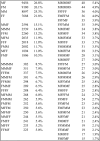Is sex at birth a biological coin toss? Insights from a longitudinal and GWAS analysis
- PMID: 40680119
- PMCID: PMC12273753
- DOI: 10.1126/sciadv.adu7402
Is sex at birth a biological coin toss? Insights from a longitudinal and GWAS analysis
Abstract
Some families consistently have offspring of only one sex, raising questions about whether sex at birth is truly random. This study investigated whether offspring sex follows a simple binomial distribution within families and identified maternal factors associated with unisexual sibships. We analyzed 58,007 US women with two or more singleton live births (146,064 pregnancies, 1956-2015). Offspring sex followed a beta-binomial rather than a simple binomial distribution, indicating that each family may have a unique probability of male or female births, akin to a weighted coin toss. Deviations from simple binomial distribution were more pronounced when we excluded each woman's last birth to reduce the influence of sex-based stopping behavior. After excluding the last birth, older maternal age at first birth was associated with higher odds of having offspring of only one sex. A genome-wide association study identified maternal SNPs linked to having female-only (NSUN6) and male-only (TSHZ1) offspring. Our findings suggest maternal factors influence offspring sex distributions.
Figures




References
-
- Gellatly C., The sex ratio: A biological and statistical conundrum. Curr. Biol. 30, R1261–R1263 (2020). - PubMed
-
- Goldman A. S., Fomina Z., Knights P. A., Hill C. J., Walker A. P., Hultén M. A., Analysis of the primary sex ratio, sex chromosome aneuploidy and diploidy in human sperm using dual-colour fluorescence in situ hybridisation. Eur. J. Hum. Genet. 1, 325–334 (1993). - PubMed
-
- Lobel S. M., Pomponio R. J., Mutter G. L., The sex ratio of normal and manipulated human sperm quantitated by the polymerase chain reaction. Fertil. Steril. 59, 387–392 (1993). - PubMed
MeSH terms
LinkOut - more resources
Full Text Sources

